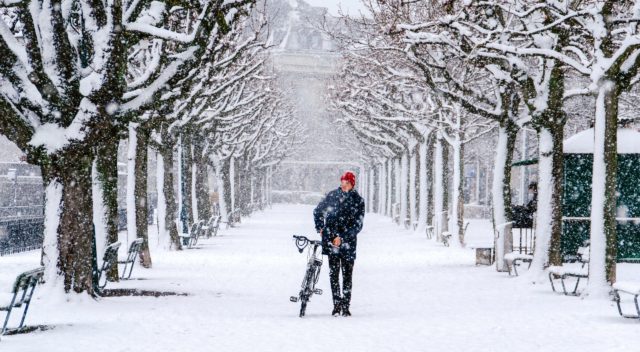December 29, 2021
Winter Cycling Tips: How Not to Slip Slide Away While Riding Through Winter

As I think about the types of crashes I’ve experienced over a few decades of almost daily cycling, most of them involved some slick or loose surface on the street or bike path, and nearly all of those situations involved turns at intersections or curves. Here are some tips for staying upright through the winter (I learned the hard way through occasional unplanned trips to the ground!):
1. Situational Awareness
Situational awareness means being aware of what’s on the road surface and under what conditions your bike can go from upright to sliding out from under you instantly. In the winter, it’s a good idea to check the forecast for upcoming snow, icy weather conditions, or frost and freezing that may occur overnight. Many of these become more common in fall and winter:
- Wet leaves
- Loose sand and gravel from road de-icing or pavement getting broken up by snowplows
- Wet or icy steel surfaces like steel mesh bridge decks or those big steel plates used to cover street construction projects
- Spilled oil
- Frost
- Frost is less of a problem on streets where air movement from vehicles evaporates dew and frost, but can be a bigger problem on bike paths where bicycles don’t create the same air movement. Frost on curvy bike paths can be difficult to detect, so check overnight and early morning weather conditions.
- Frozen melt-off
- Sure, your city did a great job of plowing the bike path on your daily commute. Still, if the temps go above freezing during the day, the plowed snow along the path melts, water runs onto the path, and then freezes overnight, so you have alternating sections of dry vs. icy bike path.
2. Turns and curves
Most of these slick conditions are more significant problems with turns and curves. Almost every slippery condition that caused me to crash occurred when I was making a turn at an intersection or navigating a curve on a bike path. So, besides being aware of slick conditions that can cause your bike to lose traction, what other steps can you take to avoid having your bike slide out from under you?
- Slow down while traveling in a straight line and BEFORE you come to a curve or turn. Avoid using brakes while your bike is rolling across a slick surface, which will cause your wheels to lock up and skid.
- Relax, and coast through it.
- Avoid tight, fast, hard-leaning turns.
- Those work great in August (and when there’s no loose gravel or sand), but not so much with frost, oil slicks, wet leaves, wet steel, and patches of ice.
3. Dealing with snow
Snow isn’t necessarily the end of bike riding; riding in the snow can be fun and invigorating!
- There are different kinds of snow.
- Most bikes can ride through even a few inches of the light, fluffy stuff.
- Snow that’s been packed down by vehicle traffic is often very rideable. Fat bikes, gravel bikes, and mountain bikes can navigate many snow conditions.
- Wet, heavy snow (like the type we get here in the northeast) can become unrideable; even with a fat or mountain bike, more than a few inches accumulates.
- If people have been walking through wet, heavy snow, forget trying to ride under those conditions. I’ve had a few episodes of pushing a bike along the last mile or so of the Hudson Greenway where snow couldn’t be plowed because it was too heavy and deep. My bike couldn’t ride on top of it (like with packed snow), and it wouldn’t cut through it (like with powdery snow).
- Studded tires for mountain and gravel bikes can help with traction in ice and snow.
4. When to bail
NYC usually does a great job of putting de-icer on streets before snow and ice arrive. But occasionally, there’s a, um, snowplow meltdown😅. Sometimes, bike facilities like bike paths on bridges and greenways are the last to get plowed and de-iced as well. It’s important to know when or where not to ride. If everything is a sheet of ice, maybe that’s a subway or work-from-home day. After an evening meeting in Brooklyn, I once rode home to the Bronx, just after a sleet/freezing rain/ice storm started. I somehow was able to ride across the Brooklyn Bridge wood bike path, which freezes quickly, and up the greenway. The Hudson Greenway had a lot of sleet on it, and my bike seemed to have traction — until it didn’t. Somewhere north of 135th, I could no longer ride in a straight line on the bike path and keep my bike upright. But I WAS able to get good traction on the adjacent grass, and when I left the bike path, the streets were wet but not icy.
5. A few more tips
- Switch to tires with a knobby tread (this probably isn’t an option for skinny-tire road bikes).
- Put your tire pressure to the lower end of its recommended pressure rating. This will give your tire more contact with snowy surfaces.
- Keep your weight on the back wheel.
- Don’t stand and pedal because your rear tire will lose traction. Use a rack and panniers to haul your stuff.
- Experiment with the right gear for traction.
- Too easy of a gear will cause your rear wheel to spin out; too hard of a gear, and you may struggle to get enough forward momentum through the snow. There’s often a gear that gets good traction without struggling for momentum.
Written by Bike New York’s Director of Education, Rich Conroy.

